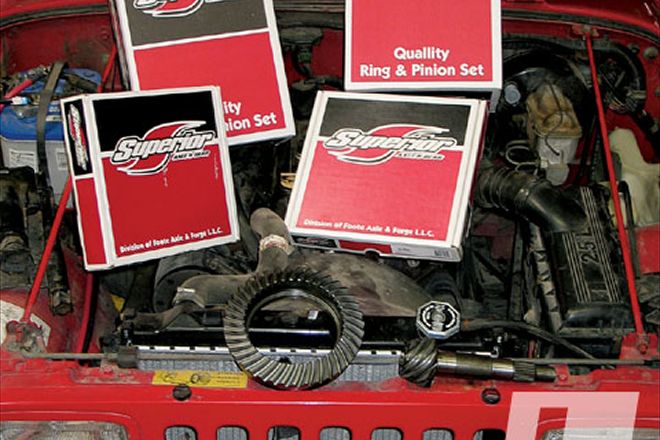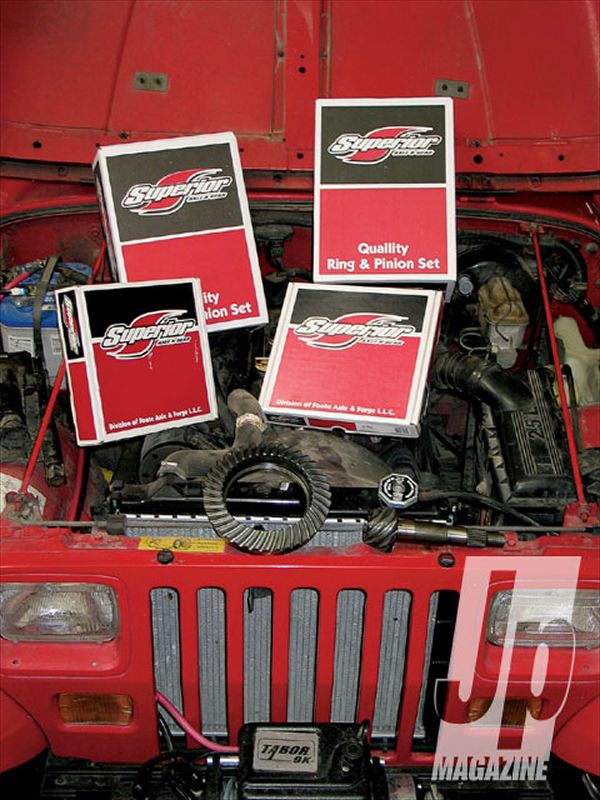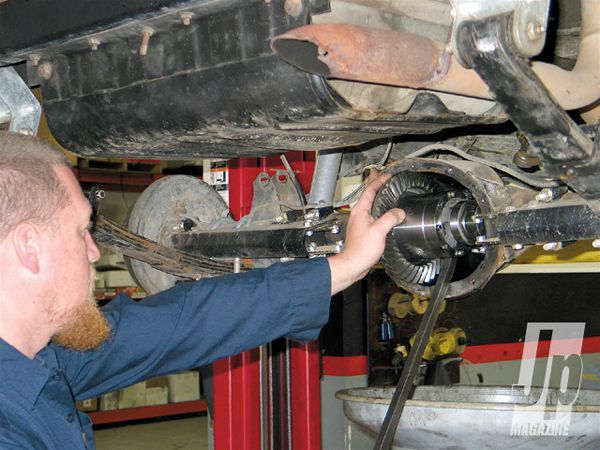
 Christian Hazel
Brand Manager, Four Wheeler
Christian Hazel
Brand Manager, Four Wheeler
 In total, the top-quality Superior Axle & Gear front and rear ring and pinion gear sets and installation kits for the Dana 30 and Dana 35 axles totaled about $590 as of press time as offered through Quadratec. Prices vary by region, but average installation labor generally runs about $250 per axle , so for purposes of this article we'll call the labor an even $500. Figure it'll run you roughly $1,090 to do a straight regear, plus or minus as much as a couple of hundred bucks.
In total, the top-quality Superior Axle & Gear front and rear ring and pinion gear sets and installation kits for the Dana 30 and Dana 35 axles totaled about $590 as of press time as offered through Quadratec. Prices vary by region, but average installation labor generally runs about $250 per axle , so for purposes of this article we'll call the labor an even $500. Figure it'll run you roughly $1,090 to do a straight regear, plus or minus as much as a couple of hundred bucks.
Ya just won't listen to me. For years I've been preaching the gospel that it's betterto regear your 2.5L's axles rather than bolting a bunch of go-fast parts to the engine. My argument was that for less money you'll get better driveability, fuel economy, and performance by changing gears. So I finally put my money where my mouth is.
Armed with the dyno data I generated with my '95 2.5L YJ, I know that adding about $1,500 in go-fast parts will get you 14hp and 7lb-ft at the rear tires. That's a lot of investment for not a lot of return considering that even with the go-fast parts the Jeep fell on its face as soon as the tire size was increased from the 29-inch rubber used on the dyno. With 31s and all the speed parts on my '95, I had to drive everywhere with my foot glued to the floor and Fifth gear was virtually useless.
So now I find myself with another 2.5L Wrangler. This time my '89 Wrangler is armed with aggressive 31-inch Super Swamper tires, an absolutely stock TBI 2.5L, AX-5 tranny, and 4.10-gears in the factory axles. Yeah, Fifth gear was useless, the Jeep couldn't maintain speed on hills, and acceleration was pretty poor.
However, rather than add any speed parts whatsoever, this time I wanted to explore the advantages of gearing versus power-adders. I bought a G-Tech Pro SS performance meter from Summit Racing to measure my 1/4-mile and 0-60mph acceleration times with the factory 4.10 gears. Once I had my baseline numbers, I ordered a set of Superior Axle & Gear 4.88 ring and pinions and install kits for the Dana 30 front and Dana 35 rear and brought the Jeep down to TAG Motorsports in Escondido, California, to have the gear swap done. With the new 4.88 gears installed, I measured my 1/4-mile and 0-60 acceleration times again. Then, with my performance numbers in hand, I used the super-accurate Intercomp race scales I got from Summit Racing a few years back to weigh the Jeep. It only took a little simple math to calculate the horsepower difference as perceived from the gear swap.

I will say this, there are a hundred different iterations of horsepower calculations you can do. These are just a couple of the easier ones to manipulate. Also, consider that the ET numbers are usually more a factor of gearing, vehicle weight, and torque combined with reaction time, while top speed at the end of the quarter mile is a much better indicator of raw horsepower. Despite all of the variables, I'll include a few different versions and will allow you to draw your own conclusions. The bottom line is that with the lower gearing the Jeep is much more drivable, acceleration is crisper, and the Jeep can maintain speed on the road much more easily than before.
Math Class
Wanna calculate your horsepower from a known vector quantity? Here are a couple of formulas that will come in handy.
The Bottom Line
Here's how the modifications stack up versus some prices found on the internet as of press time.
'95 Wrangler Speed Parts Package (Test 1): * {{{Flex}}}-A-Lite Fan PN 475 ${{{240}}} * Banks Torque Tube Header PN 51316 $430 * Banks Stinger Exhaust PN 51311 $315 * Random Technology High-Flow Cat PN 822201 $235 * 4.0L 58mm throttle body (junkyard) $350 * AEM Brute Force cold air intake PN 21-8304DP $250 Total $1,520 Results: 14hp, 7lb-ft '89 Wrangler Gearing Package (Test 2): * Superior D30 4.88 gears PN D30488R $190 * Superior D35 4.88 gears PN D35488 $190 * Superior D30 Install kit PN 25-2032 $105 * Superior D35 install kit PN 25-2049 $105 * Installation Labor (estimate) $500 Total $1,090 Results: 15.7hp 1/4-Mile Performance Data: * Test 1 with 4.10 gears (sec@mph) [email protected] * Test 2 with 4.88 gears (sec@mph) 19.{{{80}}}@70.9

